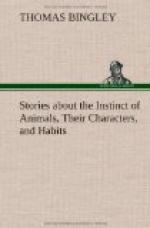CHAPTER II.
Uncle Thomas tells about the Beaver, and the Singular Manner in which it Constructs a Dam to confine the Waters of the River; and about the Hut which it builds for its Habitation. He tells also about the Curious Nests of the Sociable Grosbeak; and gives a Long and Entertaining Account of the White Ant of Africa; its Extraordinary Nest; and the Important Part which it acts in the Economy of Nature.
“Good evening, Boys! I am going to tell you about a very singular animal to-night—singular both in its conformation and its habits. I allude to the Beaver.”
“Oh, we shall be so glad to hear about the Beaver, Uncle Thomas. I have sometimes wondered what sort of an animal it is. It is of its skin that hats are made—is it not?”
“It is so, Harry—at least it is of the fur with which its skin is covered. I must tell you about the manufacture of hats at some other time. Our business at present is with the Beaver itself. I think we shall get on better by confining our attention to the animal now, and examine into its habits and instincts.”
“Very well, Uncle Thomas, we are all attention.”
“The Beaver, which is now only to be found in the more inaccessible parts of America, and the more northern countries of Europe, affords a curious instance of what may be called a compound structure. It has the fore-feet of a land animal, and the hind ones of an aquatic one—the latter only being webbed. Its tail is covered with scales like a fish, and serves to direct its course in the water, in which it spends much of its time.
“On the rivers where they abound, they form societies sometimes consisting of upwards of two hundred. They begin to assemble about the months of June and July, and generally choose for the place of their future habitation the side of some lake or river. If a lake, in which the water is always pretty nearly of a uniform level, they dispense with building a dam, but if the place they fix upon be the banks of a river, they immediately set about constructing a pier or dam, to confine the water, so that they may always have a good supply.”
“That is an instance of very singular sagacity Uncle Thomas. I suppose it is their instinct which teaches them to act in this manner.”
“You are right, Frank. Well, the mode in which they set about constructing the dam is this: having fixed upon the spot, they go into the neighbouring forest, and cut quantities of the smaller branches of trees, which they forthwith convey to the place selected, and having fixed them in the earth, interweave them strongly and closely, filling up all the crevices with mud and stones, so as soon to make a most compact construction.”




